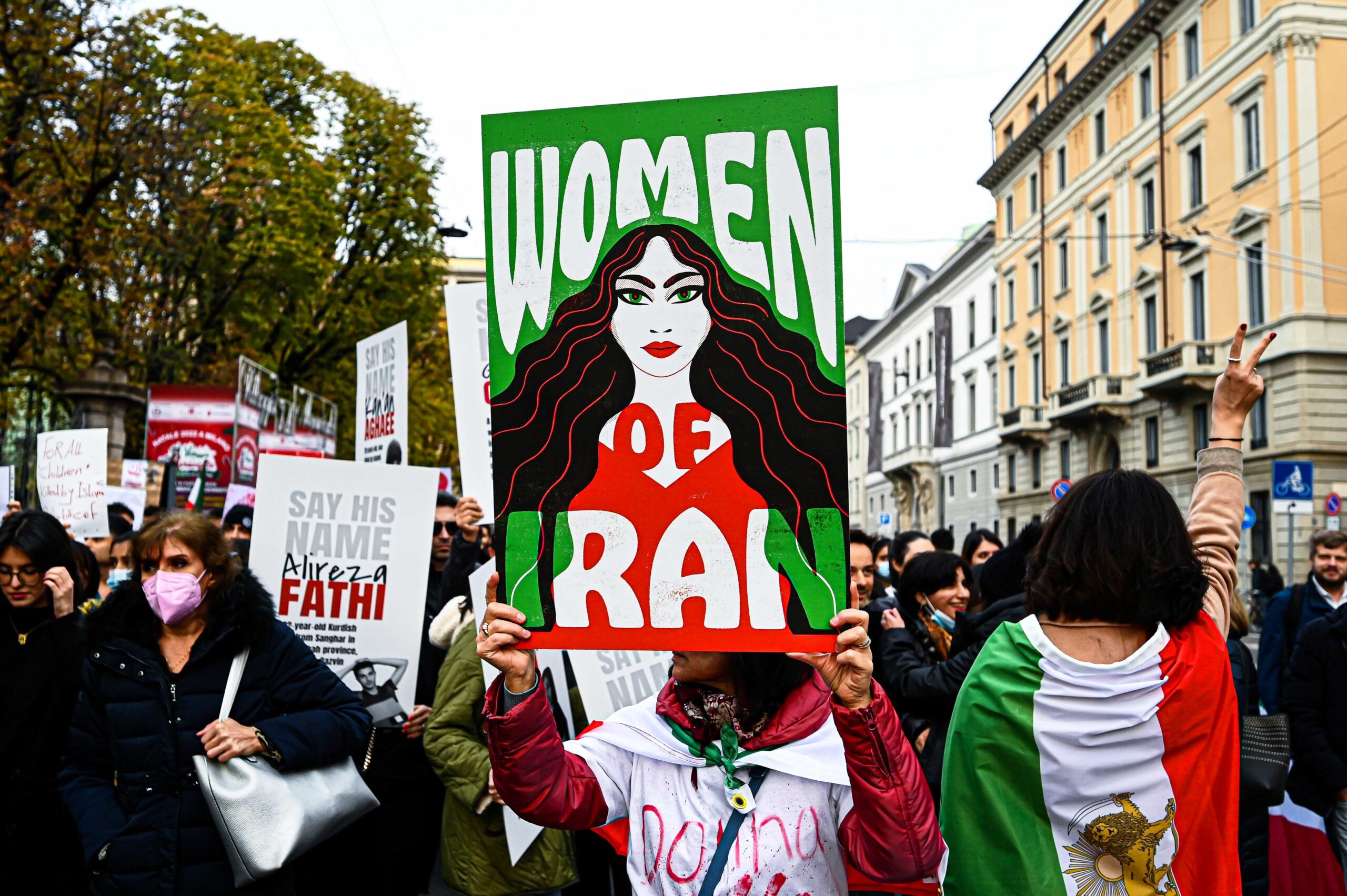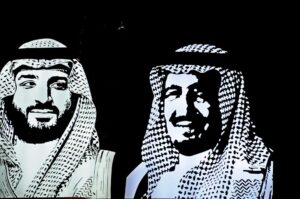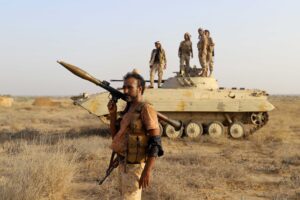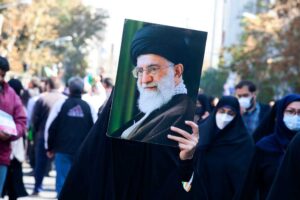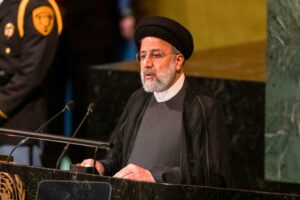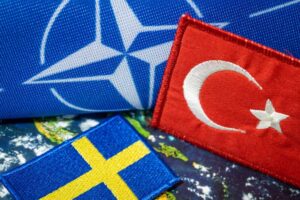Throughout history, the concept of liberation for Iranians has been something like anarchism.
The widespread protests in Iran following the death of Mahsa Amini have been analysed through different political, economic and social theories. Based on this, the weakening of the middle class, the demands of Generation Z and the women’s movement have been cited as the main reasons for the current protests. Some have also noted that Iran’s lack of political development or underdeveloped civil society is contributing to the protests. The fact that different theories have emerged to explain the protests is unsurprising; their reach across Iranian social classes and to different issues shows their complexity. Thus, to understand the protests, we cannot limit our analysis to a single theoretical framework. Looking at the protests is like looking through a prism that emphasises every aspect: each group evaluates these protests from the point of view of securing its interests.
The Nature and Roots of Iran’s Recent Protests
In these protests, we are witnessing the politicisation of the daily life of ordinary people.
According to Homayoun Katouzian, an Iranian economist, historian and sociologist, the various uprisings of the Iranian people throughout history have not involved part of the society revolting against the rest, but rather the rebellion of the society against the ruling political system.[i] In other words, throughout history, the concept of liberation for Iranians has been something like anarchism.
This contextualises the current protests in Iran, which first arose against the morality police after the death of Mahsa Amini before quickly spreading among different social classes and to many issues. The current protests are comprehensive and integrated; different classes and Iranian ethnic groups have united against the ruling system around the central message of “women, life, freedom.” This has given a new character to these protests in comparison with other protests in the Middle East.[ii]
Hence, in these protests, we are witnessing the politicisation of the daily life of ordinary people. This trend shows that the focus of society’s immediate demands has changed from “political” to a demand for “citizenship rights.” During the 1997 presidential election, Iranians, especially those from the middle class, protested the political system by electing Mohammad Khatami, a reformer. Yet if democracy, the ballot box and political action had previously been the driver of “representation” in Iran, today Iranians are demanding the right to live a normal life—not seeking it through the ballot box. Moreover, unlike the demand for political development and democracy—which has generally relied on the urban middle class—the recent protests are considered trans-class, signifying their broad appeal.[iii]
Accordingly, as sociologist Asef Bayat deduced, protesters are choosing areas where the state—which is always more powerful than the society—is not hegemonic. Therefore, citizens are mobilising and connecting via informal networks or in places where the state does not have hegemony, such as the street, which has become the centre of politics.[iv]
Revolutionary Origins
Some of Iran’s current political problems were forged in the fire of the Iranian revolution of 1979, wherein the revolutionary groups focused, first and foremost, on deposing the Shah over creating a sustainable, pluralistic political order that could respect the interests of Iran’s different social groups.[v] Consequently, in the aftermath of the 1979 revolution—that is, from the very beginning of contemporary Iran—different groups within a fractured society began to gain power and eliminate rivals. In fact, this trend is one of the central and fundamental reasons for the recent protests in Iran.
Since the 1979 revolution, we have seen the formation of two types of institutions of power in Iran: the first, electoral institutions including the Islamic Council and the Presidency; the second, revolutionary institutions that are appointed by and operate under the supervision of the Supreme Leader of Iran. The candidates for parliament and the presidency, notably, must be approved by the Guardian Council, which also falls under the oversight of the Supreme Leader.
The revolutionary institutions were considered the tools of power of the Islamist movements (both left and right) against the secular and liberal movements. Although the interim government of Mehdi Bazargan (4 February 1979–6 November 1979) managed the government’s official and legal apparatus, the revolutionary institutions held most of the real power. At the head of the revolutionary institutions was the Revolutionary Council, which supervised the revolutionary committees (substitutes for the police), the Revolutionary Guards and the Revolutionary Courts.[vi]
The power struggle between the Bazargan government, a coalition of moderate and liberal parties, with the revolutionary institutions, which were dominated by clerics, finally led to the decline and collapse of the interim government. Subsequently, the Bazargan government’s proposals to remove the independent power centres, integrate the Revolutionary Guards into the army and break up the revolutionary committees were not realised.[vii] In general, Iran’s system of “dual sovereignty” ended to the detriment of liberal and moderate parties and groups and to the benefit of Iranian conservatives. This new reality was then reflected in the approval of a new constitution that provided the foundation for the formal and legal recognition of Iran’s revolutionary institutions. According to political sociologist Hossein Bashiriyeh, it is these failures that limited the room for competition and political participation in Iran’s future governance.[viii]
The Unity of Political Power
After the secular and liberal groups were abandoned, dual sovereignty became relevant in connection with the competition between the Islamic left and the Islamic right. On this basis, the revolutionary institutions were mainly in the hands of the Islamic right, while the democratic institutions such as the parliament and the presidency were exchanged between the Islamic right and the Islamic left.
The incompetence of Iran’s democratic institutions has been a perennial concern for Iranian elites.
However, according to theorists like Bashiriyeh, after 1989, Iran’s democratic institutions such as the parliament and presidency have become more active. According to this interpretation, the Islamic Republic has evolved from the ideological state that existed in the early years of the revolution to a “facade democracy” and then to a “quasi-democracy.” In this quasi-democracy, if the legitimacy and prestige of the traditional oligarchy (clergy class) and the democratic institutions weaken, the state’s military forces become more important.[ix]
The incompetence of Iran’s democratic institutions has been a perennial concern for Iranian elites, especially reformists. When US President Donald Trump’s withdrawal from the Joint Comprehensive Plan of Action (JCPOA) in 2018 undermined Iran’s economic situation, conservatives assessed that these conditions were a result of reformers’ trust in the West.[x] This weakened the position of the moderate president, Hassan Rouhani, as well as Iranian reformers more broadly.
After the election of US President Joe Biden, some Iranian reformers assessed that the next Iranian government would be allowed to restart the JCPOA negotiations if a conservative was elected in the country’s June 2021 presidential elections (which later occurred with the election of Ebrahim Raisi). At the time, some prominent reformist figures, including Saeed Hajjarian, proposed that Rouhani should resign in order to form a “unified sovereignty” where both Iran’s democratic (presidency and parliament) and revolutionary institutions would be led by the Islamic right.[xi]
This issue indicated that the revolutionary elites in Tehran’s political structure were unwilling to allow the reformist movement to score points through the revival of the nuclear agreement. At the time, the revival of the JCPOA could have attracted the social body of reformers, i.e., the middle class, to participate in the country’s elections (in 2021) after being noticeably absent in Iran’s 2019 parliamentary elections.[xii]
Of course, one of the reasons for the reformists’ gradual elimination is their poor performance while they have been in power. Some of the “reformers” in power were opportunistic, using the banner of reformism simply to gain power.[xiii] Because of this, Mohammad Reza Tajik, former President Khatami’s political advisor, argued that the discourse of reformism needs to have a new organisational structure and “younger, fresher, more creative, more motivated and healthier forces” in order to “free the reformist movement from the current situation.”[xiv]
Reformists recognise that they no longer have a place in the political power structure of Iran.
These warnings came as the Iranian middle class, already fed up with Iranian reformists’ poor political record, began to believe that there is no hope of reforming Iran’s political structure.[xv] Iranians’ general disillusionment with reformism explains why the middle class did not participate in the 2019 parliamentary and 2021 presidential elections, despite Khatami and other reformist leaders encouraging reformist supporters to participate.[xvi] This is in stark contrast to 2013 and 2017, when Khatami’s efforts to rally the public in support of Hassan Rouhani resulted in the latter winning the presidency.[xvii]
However, in 2018, Khatami himself predicted this issue, saying “if I encourage people to participate in the elections, they will no longer listen to me.”[xviii] In fact, reformist elites are well aware that Iran’s political system has failed to respond to reformist demands and that their credibility has suffered. Based on this, reformists recognise that they no longer have a place in the political power structure of Iran.[xix]
Failure of the Reformist Project
That Iranians of all social and economic classes have protested the political system indicates how Iranian reformists have failed to tap into issues that create class solidarity across Iranian society. This is a result of the gradual removal of real reformers from Iran’s political power structure by both conservatives and some opportunistic reformists. It was the reformists’ poor performance that entrenched the middle class’s sentiment that there is no difference between the reformists and the conservatives; both groups seek to preserve their own interests. This manifests in the slogan of the protesters “reformers and conservatives, the story is over,” which was first used during the 2017–18 protests (Dey Protests).[xx]
The radicalisation of the middle class has also affected Generation Z, a group that has played a critical role in Iran’s current protests. This generation is heavily influenced by the internet and, therefore, has the possibility to compare its situation with its peers all over the world. Generation X, which has largely been responsible for educating Generation Z, is also the same generation that has grown disappointed with reformists.[xxi]
The opportunity for reform may be gone. It is noteworthy that the protestors are neither waiting for nor seeking guidance from the country’s reformists.[xxii] Indeed, the current situation shows that there will not be significant difference between real reforms and revolution; if the political system wants to respond to the demands of the people with a sincere effort at reform, it requires making fundamental ideological and governmental changes to the political system.
The protestors’ greatest achievement so far is that they have raised the possibility of a new Iranian political order. They have created solidarity among different social groups based on common pain and “wanting a normal life.” Structural reforms are the only way to meet the protestors’ demands.
[i] Mohamad Ali Homayoun (Homa) Katouzian, Nine articles in the historical sociology of Iran’s oil and economic development, Tehran: Markaz, 2015, pp.34, 35.
[ii] Javad Heiran-Nia, “How Far Will Iran’s Protests Go?” National Interest, October 8, 2022, https://nationalinterest.org/blog/middle-east-watch/how-far-will-iran%E2%80%99s-protests-go-205220.
[iii] “Hajjarian’s analysis of changing the center of society’s immediate demands from politics to citizenship rights”, Khabar Online, October 22, 2022, https://www.khabaronline.ir/news/1682799.
[iv] Bayat, A., Life as Politics: How Ordinary People Change the Middle East, Amsterdam: Amsterdam University Press, 2010, p.14.
[v] Mohsen Milani, The Making of Iran’s Islamic Revolution: From Monarchy to Islamic Republic, Routledge, 1994.
[vi] Hossein Bashiriyeh, An introduction to Iranian political sociology, Tehran: Negah-e Moaser Press, 2002.
[vii] Javad Heiran Nia, “The institutional roots of Iran’s protests”, Atlantic Council, October 6, 2022, https://www.atlanticcouncil.org/blogs/iransource/the-institutional-roots-of-irans-protests/.
[viii] Ibid.
[ix] Bashiriyeh, An introduction to Iranian political sociology.
[x] Djavad Salehi-Isfahani, “Impact of sanctions on Household welfare and employment”, The SAIS Initiative for Research on Contemporary Iran Johns Hopkins University, August 11, 2022,
[xi] Saeed Hajjarian, “Which reformism? which survival?” Mashghe Now, May 11, 2019, https://mashghenow.com/?p=1476.
[xii] Saman Safarzaei, “The unfulfilled dream of the middle class”, Shargh Daily, October 11, 2022, https://www.sharghdaily.com/fa/tiny/news-858259.
[xiii] Saeed Hajjarian, “Opportunism or reformism?” Mashghe Now, September 25, 2021, https://mashghenow.com/?p=5105.
[xiv] Mohammad Reza Tajik, “Civil activists have passed reformism but…,” Ensaf News, March 27, 2021, http://www.ensafnews.com/288063.
[xv] Mohammad Reza Tajik, “Behind the scenes of electoral movements: reformists, civil activists have passed reformists”, Shargh Daily, March 13, 2021. https://www.magiran.com/article/4159055.
[xvi] “Khatami: The system has passed us by,” Negaam News, February 11, 2021, https://negaam.news/%d8%ae%d8%a7%d8%aa%d9%85%db%8c-%d9%86%d8%b8%d8%a7%d9%85-%d8%a7%d8%b2-%d9%85%d8%a7-%d8%b9%d8%a8%d9%88%d8%b1-%da%a9%d8%b1%d8%af%d9%87-%d8%a7%d8%b3%d8%aa/.
[xvii] Yeganeh Torbati, “Khatami, reformists back Rouhani in Iran presidential vote”, Reuters, 11 June 2013. https://www.reuters.com/article/us-iran-election/khatami-reformists-back-rohani-in-iran-presidential-vote-idUSBRE95A09O20130611; Erin Cunningham and Brian Murphy, “Iran’s Rouhani secures endorsement of key pro-reform leader ahead of elections”, Washington Post, 3 May 2017.
[xviii] “Khatami: The system has passed us by”, Negaam News, February 11, 2021, https://negaam.news/%d8%ae%d8%a7%d8%aa%d9%85%db%8c-%d9%86%d8%b8%d8%a7%d9%85-%d8%a7%d8%b2-%d9%85%d8%a7-%d8%b9%d8%a8%d9%88%d8%b1-%da%a9%d8%b1%d8%af%d9%87-%d8%a7%d8%b3%d8%aa/.
[xix] Mohammad Reza Tajik, “Civil activists have passed reformism but…”, Ensaf News, March 27, 2021, http://www.ensafnews.com/288063.
[xx] “The emergence of a new class of protestors; What does the slogan ‘reformers and conservatives, the story is over’ indicate?” Aftab News, December 21, 2019, https://aftabnews.ir/fa/news/627714.
[xxi] Javad Heiran-Nia, “How Far Will Iran’s Protests Go?” National Interest, October 8, 2022, https://nationalinterest.org/blog/middle-east-watch/how-far-will-iran%E2%80%99s-protests-go-205220.
[xxii] “Unconsciously focused on life”, Shargh Daily, November 21, 2022, https://www.sharghdaily.com/fa/tiny/news-862034.

